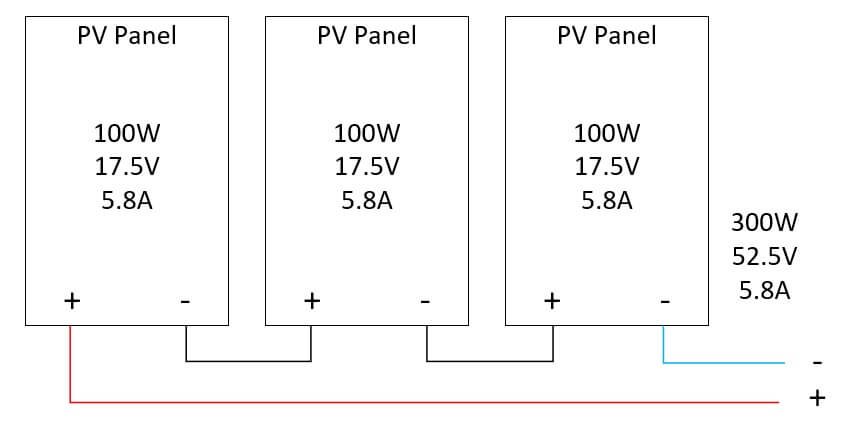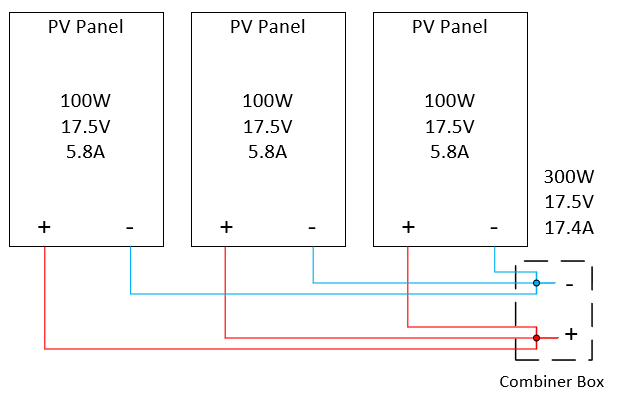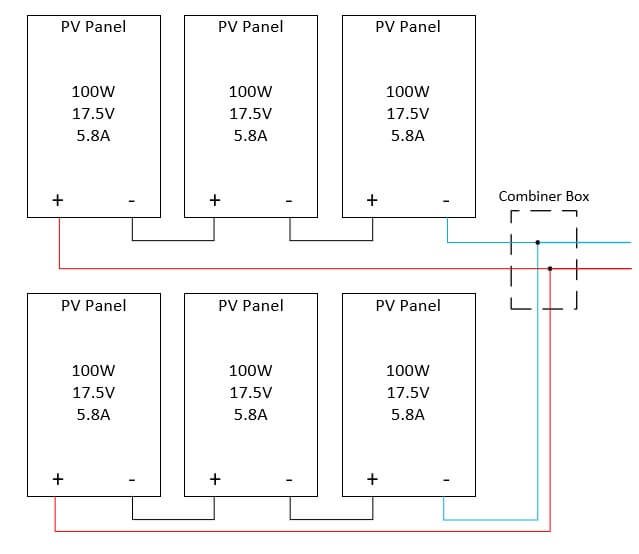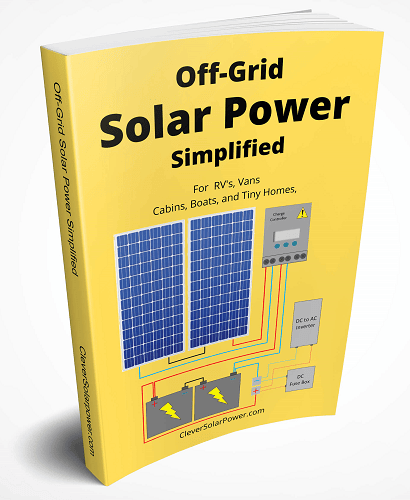Let me take a guess:
You are confused because you are pretty much overwhelmed about the different wiring methods of solar panels. The manufacturer may have mentioned a thing or two about series and parallel wiring and left you with so many questions.
If you are new to solar panel systems, you may wonder, does wiring them in a specific way even matter? Short answer: yes, it does. The wiring of solar panels has a significant impact on how they are going to perform.
In this article, I will review series vs. parallel wiring of solar panels in detail.
Let’s see what I have in store for you.
Comparison Between Parallel and Series Circuits
Before we talk about the wiring of solar panels, let’s do a quick revision. What exactly is meant by parallel and series circuits? Here is everything you need to know:
Parallel Circuits
Have a look at the switchboard in your room. You will see there are different switches for different uses. Turning on the light, would not automatically turn on your fan. This is because your switchboard has a parallel circuit. What exactly do we mean by that?
In a parallel connection, current flows along the multiple routes. Let’s suppose one of the switches in your switchboard stops working. Now, would it affect the other switches in the same switchboard? Most certainly, it will not.
Since parallel circuits have multiple paths, the current will flow along with the switches that are working, ignoring the broken one.
Across every path, the voltage remains the same, whereas the current adds up. You can calculate the total current by adding up the amps from each path.
Series Circuits
To understand a series circuit, we will have a look at a simple example. Your refrigerator and freezer have a series connection. If you turn off the switch, both of them will stop working. What do you think is going on?
Contrary to parallel circuits, series circuits have a single path for the current to flow. The current doesn’t have any paths to divide itself. Therefore, it doesn’t vary. The overall current stays the same, whereas the voltage across each resistor in a series circuit varies.
In a series connection, voltage is added up while current stays the same.
Can you easily differentiate between the two circuit connections now? That’s great. Now, we will see how we can relate our knowledge regarding parallel and series circuits in a solar panel array.
Series vs Parallel Wiring of Solar Panels
Similar to batteries, solar panels also come with a positive and negative terminal. With the help of these terminals, you can connect the solar panels in the desired fashion. So, let’s start with the series wiring of a solar panel system as it is less complicated than the parallel wiring.
What Happens in Series Wiring of Solar Panels?
The assembly procedure is quite simple because you don’t need to use any additional equipment. Let’s suppose you have four solar panels. To connect them in series, you have to join the positive terminal of your first solar panel to the negative side of your second terminal. Once you have attached all the solar panels side by side, you will see they have formed a string.
In the series wiring of solar panels, you will need a single wire to connect each solar panel in a string. If you are planning to install solar panels for your house, then the wire should come from the roof.

Tip: You can add up as many solar panels in series as your charge controller can handle. This is usually 100V DC.
The total voltage and current stays the same until it reaches the charge controller, which is a device to regulates voltage and current. From there, it will charge your battery.
Wire Thickness
As you have wired the solar panels in series, the voltage across each solar panel sums up to the total voltage. On the other hand, the amperage of electrical current for each solar panel will stay the same.
If the current doesn’t increase, there is no need to use bigger cables. You can still use the cables that the solar panel comes with. You might have to increase the size when you have to cover large distances to reduce voltage drop.
What Happens in Parallel Wiring of Solar Panels?
Do you know why parallel wiring is more technical?
Any guesses?
Don’t worry; Here is the answer:
In parallel wiring, you don’t have to play with a single wire. This is where it gets a little complicated.
Besides that, your installer will most likely install a combiner box before the charge controller. The main purpose of a combiner box is to transfer the combined output from multiple solar panels strings to an inverter.

We will get to that part later on. For now, let’s see how to connect the solar panels in parallel.
As you know, parallel circuits have multiple wirings. This setup allows the current to flow in different paths. We will apply the same phenomena here.
For that, we need two centralized wires from a house roof.
- The first central wire will attach with the positive terminal wires of the solar panels
- The second centralized wire will connect with the wires of negative terminals.
Wire thickness
Here, you have to be mindful of the amperage of the electric current. It adds up while the voltage stays constant across each solar panel.
You can use the same thickness of cable that is supplied with the solar panel up to the combiner box. The parallel connection is usually made in the combiner box. You should use the appropriate wire size to go from the combiner box to the charge controller.
Wiring in parallel will be more expensive than series because of the cost of wire.
Is Parallel Wiring the Right Fit for your Solar Panels?
If you look at the circuits closely, you will realize that parallel wiring turns out to be a better option. If your home appliances have a parallel connection, they will continue to work independently.
However, there is a small catch. You may think it won’t make a difference if one of the panels stops functioning. The other panels will be there to cover up for the malfunctioning one, right? Well, things are slightly different here.
With parallel wiring of the solar panels, you will have less voltage and more amperage. Remember, you need a greater value of the voltage to charge a battery. The solar panels in parallel connection have to function around 75% capacity to produce enough voltage for charging batteries. That sounds like a lot of work, for sure.
In short, if your battery bank is 24 volts but the solar panels are 17 volts, it’s not very efficient to charge your batteries.
Is Series Wiring the Right Fit for Your Solar Panels?
On the other hand, the series wiring will give a greater value of voltage.
Can you join the dots now? The manufacturer may have suggested the series wiring because of this particular reason.
Another question: Does this mean there are no downsides of using the series wiring for your solar panels?
Unfortunately, it’s not perfect with the series wiring either. To be honest, a single shaded panel is enough to affect the overall performance of your solar panel system. That’s not something you are looking for. If have written an article about the effects of shading on solar panels. Check it out here: solar panel shading.
Hybrid Wiring of Solar Panels
Yes, you read that right. Your solar panel supplier can choose to combine the series-parallel wiring. The hybrid wiring is a bit more complicated but totally worth it.
It depends on the ratio between voltage and amperage. This particular type of wiring keeps a good balance between them. And most of the time, this wiring setup renders good performance from the solar panel systems.
However, you simply can’t ignore what you need solar panels for; this is the primary deciding factor for your solar-panel wiring. Your installer will install the solar panel system according to your requirements. Having said that, what may work best for you probably won’t work best for someone else.

Conclusion
- Use series wiring if you have no shade on your solar panels. Be mindful of winter conditions when the sun is lower. Go as high in voltage as the input of your solar charge controller permits.
- You can use hybrid connections if your series connection has reached 100Volts DC.
- If you expect shade, use parallel connections. This will be more expensive in wiring cost but you will get better performance of the panels.
Watch my video here:
FAQ
RV solar panels in series or parallel?
I recommend wiring your RV solar panels in parallel. This is to minimize the loss of partial shade on one or more of your panels. This will cost more in wiring, but will make the system more efficient in case there is shade.
You have to be careful of the panel voltage. If you wire your panels in parallel, the voltage can dip under your battery voltage, making it harder for your battery to charge early and late in the day, as well as on overcast days.
Is it better to have solar panels in series or parallel?
It’s cheaper to wire your panels in series up until the allowable input voltage of the charge controller. This will be cheaper on wiring and increase energy capture in early and late sun hours. If the voltage reached the max input of your charge controller, then use a hybrid system.
Which is safer series or parallel?
I would argue that series is safer than parallel. This is because the fault current is limited in a series connection. The wires have to be less thick, which doesn’t have the need for calculations. In a parallel setup, you have to fuse every panel. In a series setup, you only have to fuse the series string. This reasoning is up for debate. Let me know in the comments what you think.
 I have written a book that contains all the information you need to get started with off-grid solar power.
I have written a book that contains all the information you need to get started with off-grid solar power.
With over 1,300 reviews at 4.5 stars, I can almost guarantee you that this book will save you $100’s on buying the right equipment.
You can buy it here on Amazon.com

I’m an off-grid enthusiast. I created this website to give clear and straight-to-the-point advice about solar power. I’m also the author of the book ‘Off-grid solar power simplified‘. Read more about me on my about page, check out my Youtube channel, or send me a message.
On the hybrid wouldn’t the volts be 105 and the watts 600?
If you are referring to the last image, I will do the calculation for you.
First, do the series connection:
17.5Volts * 3 = 52.5 Volts
5.8 Amps (in series, voltage adds up, current stays the same)
We will regard one string of panels as one panel of 52.5 volts at 5.8 amps.
Now we have to parallel panels of 52.5 volts and 5.8 amps.
In parallel, the voltage stays the same but the current adds up. This becomes 52.5 volts and 11.6 amps with a total of 609 watts.
Hope this helps.
Hi Nick,
I came to the same conclusion before I found the answer here at the bottom. 😄
Thanks for taking the time to put all the info together and explain everything very clear. I am starting to learn about solar power because I want to build an off grid system for our our new house which is located quite remote.
Your website is a nice read. 👍🏼
Hi, I want to add an extra panel to my camper there will be 2 100 watt 18 volt panels, my controller will handle both the amps and volts, do I go parallel or series, battery bank is 2 90amp leisure batteries. Thanks,Dennis.
Hello Dennis, I’m sorry for the late reply. I recommend putting them in series. This way, you don’t lose as much power from the cables. So they can be thinner and cheaper.
Will it be OK to have two or three 120W panels wired in series to a controller which charges a 12 Volt leisure battery (1st priority) and a 12 Volt starter battery. How would I best do this. I haven’t quite decided about the 3rd panel. The RV is used mostly in the west of Scotland with more than its share of cloud and rain. Further to my earlier email I have found that the max Input for the controller is 41V. I would probably now intend to initially install two 120W Panels in series. Would it then be possible to add a third Panel in parallel to the controller if it was found that more solar input was required. How should this be done. Would I need to go further and pair two lots of 2 panels in series and connect them then in parallel to the controller
Hello Gavin, Is your controller PWM? If it is, I recommend changing to a MPPT, they can usually take 100 VDC input voltage, and are more efficient.
It’s not a good idea to put two panels in series and one in parallel. You will have an unbalanced system. Either you will have to add another panel, or put them all in series. Like this: 2 panels in series which makes a parallel connection with another 2 panels in series.
I may need to harvest more power to charge my 200AH lithium battery. I currently have three panels, No-name 175 watt panel, two Kyocera panels, a 135 and a 140 watt all wired in parallel to Victron 100/30 MPPT. I was thinking of adding a second 175 watt panel along with a second Victron 10/20 MPPT. Would it be better to wire panels in series – two 175 watt to the 100/30 and two Kyocera panels to the 100/20? Or would parallel wiring scheme for each pair of panels be better. This is on a fifth wheel trailer with about 10 feet between panel pairs and chargers. Trailer would be in various sites some with shade some without shade most in western Colorado and eastern Utah.
This is what I recommend with mismatched panels: Connect them in parallel if they have the same voltage. Connect in series when they have the same current. I would connect the two 175 Watt panels to the 100/30 and the other two to the 100/20 if they have the same specs. Refer to my article about connecting multiple charge controllers to one battery bank: https://cleversolarpower.com/multiple-charge-controllers/
For the Hybrid you tie series strings in parallel. What about Parallel Strings tied in series? Or some combination such as two panel series strings tied in parallel in series with another set tied the same way?
That would be possible. However, I don’t think that is useful. The reason is that if you do parallel, you have to increase wire diameter. If you make it series, then parallel in the combiner box, you need to use thicker wire from the combiner box to the charge controller. If you parallel at the panel itself, then you will have wire losses because the diameter is smaller. So to keep it simple, cheap, and reduce the voltage drop do series first, then combine into parallel in the combiner box.
With a parallel/series hybrid system, if one of the 2 strings is shaded and one in full sun does the system put out half its rated power or is there a further penalty?
Due to lack of roof surface facing the right direction what i am looking at doing is putting 600w facing east and 600w facing west to catch morning and afternoon sun and both those strings will be going onto a DC water heating element in my domestic hotwater cylinder.
The element itself is configured as 2 600w dc elements plus a 1000w ac element all mounted in the same screw in fitting.
It can be wired as either two separate 600w elements or paralleled to form one 1200w element.
Would i be better off wiring it as a hybrid series/parallel system, or buying the extra breakers and wire and doing it as two separate stand alone systems?
Cheers
Callum
Hello Callum,
I have made some drawings about your system. I recommend you do the same to understand it. Read my article about shading here: https://cleversolarpower.com/shading-solar-panels/
Since both strings are placed in parallel (east and west) it’s ok to combine them in parallel. Do not combine east and west in series.
If east has 600W and west has 180W, then the output will be 720W if wired in parallel. If east and west are wired in series, then you will have 240W.
To answer your question, it’s best to have a series/parallel system. No need to buy extra wires. Do mind your voltage drop though. You will have to buy another fuse for the parallel connection. Send me an email if you have more questions.
Nick, thanks for helping people out on this solar inverter systems.
I have a 12 monocrystalline solar panels with Pmax of 380 watts and Voltage at Pmax (Vmp) of 38.6V and Current at Pmax (I mp) of 9.84A installed last week Friday 11-03-22 on my roof and four 200Ah sealed SMF type batteries installed with a 60 A MPK 60 MPPT battery charger with auto select voltage of 12v/24v/48v and a Hausstrom 5.5 KVA 48V DC input to 240V AC output UPS/Inverter. The installer took all the manuals away. I can see he connected our four 200 AH 12 V batteries in series to meet the 48V DC input requirement of the Hausstrom 5.5 KVA 48V UPS/Inverter. The problem is that we have only 12x 200AH out of our four batteries, reducing drastically our backup time. We want minimum charging time, but maximum discharge time, resulting in longer back up time. We are prepared to replace the 60 A charge controller and/or the Hausstrom 5.5 KVA 48 V DC input UPS/Inverter with any good charge controller and/or Inverter that has multi DC inputs like 12v/24v/36v/48v, so that the Solar system will be redesigned -reconfigured- to give us max backup time. Our Electrical load currently is max 12%, yet because of the restriction of the series connection of the four batteries, the backup time is just about 10 hours.
Please help to advice us on the configurations of the solar panels to adopt, the specifications of the charge controller that may used in such configuration and the specification of the UPS/Inverter system we may deply to give us longer back up time.
Is it possible to connect the 12 solar panels in parallel and all four batteries in parallel. If yes, what specification of charge controller and UPS/Inverter system should we looking for?
Well, that’s kind of a long question 😉
I can give you a few pointers. Connect your panels in series until you reach the maximum amount of voltage the charge controller can handle. Then wire these sets in parallel for a hybrid setup.
You need a 48V system because you have a 5,5kva inverter. Otherwise current will be too high. But the c-rate of those batteries is only 0.2C. Which means 40amps. You inverter draws 114amps. This will reduce the capacity of your batteries. Read my article about correct c-rate and voltage here: https://cleversolarpower.com/how-many-batteries-for-3000-watt-inverter/ if you have more questions you can email me.
Thanks for your articles and help.
My question is if I have a single 12V Lithium battery and two panels (say 175W) can I still put the panels in series if I’m using a Renogy 40A MPPT controller that’s rated for 100V in?
My confusion lies in : does the input voltage to the MPPT controller have to match the output voltage? (12V battery; therefore 12V solar)
Thanks!
Hello Jason. You should wire them in series. The MPPT charge controller is a voltage controller. The higher input voltage will be transformed into a lower voltage, but it will increase the current. With a PWM it should match the battery voltage. Read my article about charge controllers to know more: https://cleversolarpower.com/pwm-vs-mppt-solar-charge-controller/
Awesome, thanks Nick! Series was the answer I was hoping for :). I’ve been reading up on all things solar and this was the missing link for me. You know – when you get a nagging question that you just can’t seem to find the answer for. Until now. Much appreciated!
By the way… small thanks for your help, I just bought a copy of your book from the article. Cheers.
I currently have one panel that gets the morning sun, and some into the afternoon. I would like to add a 2nd panel, on a different angle, to grab the late day sun. From your write-up, am I correct in thinking I should wire them in parallel?
thank you,
Steve
Correct, because sun has effect on current, not voltage. In parallel, voltage stays the same and current gets added up. While in series, voltage adds up and current will be the lowest of the two panels. You can also wire the second panel to another charge controller.
Thanks Nick for your articles and help.
I am pretty much new to solar and off grid systems.
I moved to a friends off-grid accomodation and I found this exisiting setup:
There are six panels (each: 250W, Voc 23.37V , Lpm 13.37A) that are connected with 60Amp controller to 8 batteries (160AH each) connected in parallel. So I have 12 volts in the batteries and 3Kw inverter. Everything works fine in the summer and when there is enough sunlight, but in the winter I need more power.
I was given 4 extra panels ( each: 250W, Voc 37.25V, Lmp 8.31A)
My question is: How can I wire the panels and can I connect a controller (12/24V, 30A, 50Voc) and give to the batteries an extra boost of energy from this new and separate PV array? Thanks, Robert
Hello Robert, I recommend adding another charge controller for the 4 extra panels. You can read my article here about multiple charge controllers (they don’t need to communicate with each other). If you have full sun, you should wire the 4 panels in series. 250W*4panels=1,000W. 1,000W/12 battery voltage = 83A charge controller. You need a bigger charge controller and you should increase the battery voltage to 24V at least. Read my article about how many batteries you need for a 3,000W inverter.
Thank you Nick for your reply and for your help…..
Hello Robert, i want to draw solar panel diagram to teach students. i also want to use it in powerpoint and i have seen your solar panel diagrams in your book and your videos. can you tell me which programs you are using. I will appreciate that if you tell me.
I use edrawmax by wondershare.